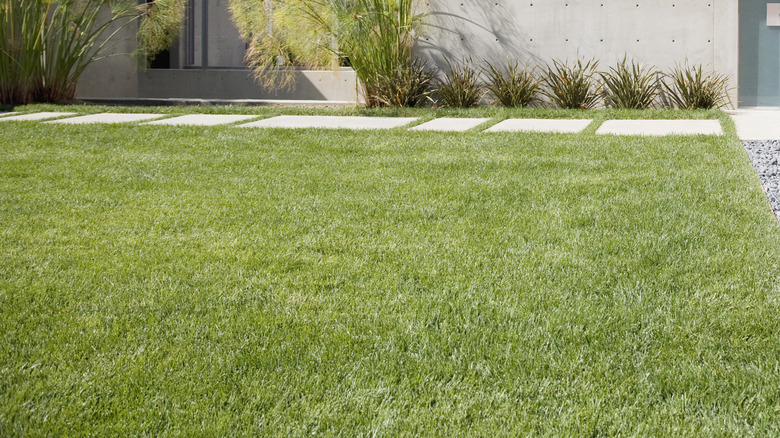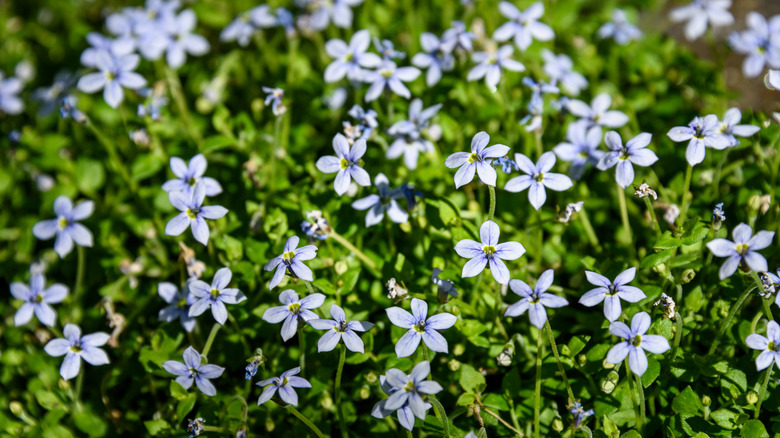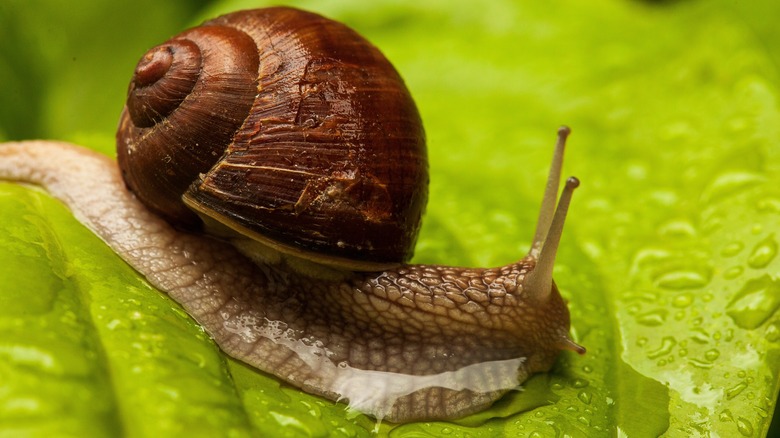The No-Maintenance Lawn Care Project You Should Start In The Spring
Blue star creeper (Isotoma fluviatilis) is a fairly evergreen plant known for its star-shaped blue flowers. This flowering perennial is the perfect ground cover for replacing grass with a low-maintenance plant that requires much less water than a traditional lawn. Covered in flowers from spring to early summer, it forms a dense, low-growing mat of foliage that crowds out weeds. You probably don't want to play rugby on it, but blue star creeper can tolerate moderate foot traffic.
This fast-growing ground cover should reach its mature size and cover your lawn area in just one season. It spreads by underground runners but is not invasive. Deer and rabbits aren't big fans, so they are not likely to munch on it unless there are few other food options. This flowering plant tolerates short, dry spells and is known for attracting bees, butterflies, and other beneficial insects. Planting blue star creeper as a substitute for grass is a project any homeowner can do themselves.
Why you should use blue star creeper to replace your lawn
According to Columbia Climate School, lawnmowers are responsible for 5% of the world's air pollution. Grass lawns are also a considerable drain on freshwater supplies in urban areas and a serious water guzzler in warmer climates. In today's world, as we have become more aware of the dangers of mismanaging our planet's resources, this is significant. But you don't have to choose between a gorgeous outdoor space and helping the Earth. You can replace some or all of your existing lawn with more eco-friendly plant choices. Blue star creeper is one such plant.
Choose a spot for your blue star creeper that is sunny, keeping in mind that this is a ground cover that loves shade in warmer areas. To replace your present lawn, first start by removing the existing sod. You can spray it with an herbicide first to prevent the roots from regrowing and competing with your new ground cover. Using a square-nose shovel, cut and remove the grass. Then plant blue star creeper 12 inches apart so that it covers the space quickly. Mulch between the plants to conserve moisture until the plants fill in. Keep moist for at least two months or until established.
How to grow and plant blue star creeper
Growing this low-maintenance plant couldn't be easier. Give it well-draining, moist soil. However, don't overwater or let the plants sit in water, as they can be prone to root rot in those conditions. This plant loves sun but does well in dappled or partial shade, especially in southern states. Blue star creeper appreciates an all-purpose fertilizer in the spring. Don't overfertilize, though, or you may encourage aggressive spreading.
While blue star creeper is generally free of pests, you will have to learn to keep snails and slugs out of the garden, especially in spring. To help the plant stay compact and to encourage flowering, mow the ground cover in early fall to 1-2 inches tall. Blue star creeper is toxic if eaten — so it might not be the best choice if children or pets are a factor — and the cut foliage can cause skin irritation. Using gloves can protect your hands when planting or caring for these plants. It is hardy from Zones 6-8 and can tolerate temperatures down to minus 4 degrees Fahrenheit. And if you find you love your new blue star creeper replacement lawn, you can cut root divisions off the thriving plants in fall and replant in other areas.


